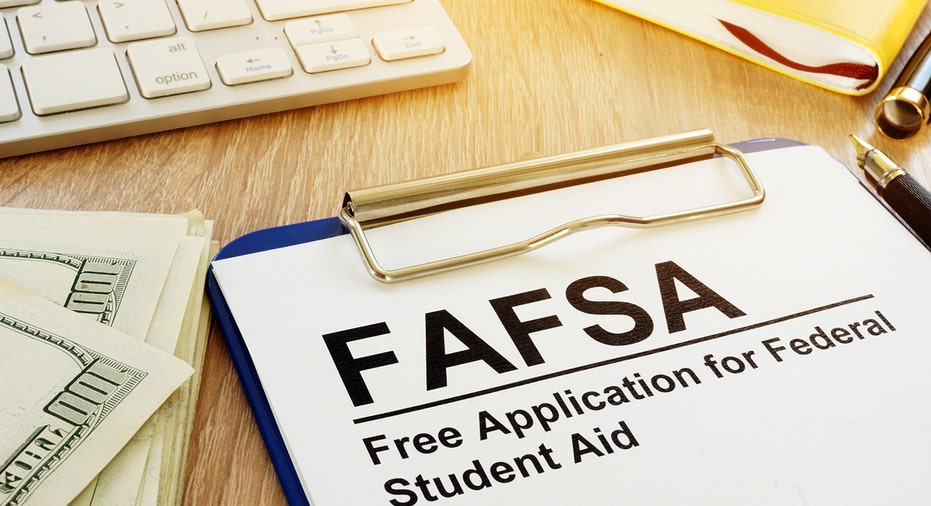Applying for FAFSA is about to get a lot easier

If you're thinking of applying for federal student aid there are some changes to the process to be aware of. (iStock)
If you're planning on attending college and conducting a college search, determining when and how to apply for FAFSA – or Free Application for Federal Student Aid – is one of the most important steps you'll need to take. It's is essential to access federal student loans, work study programs, and even many financial aid options from states and schools.
Unfortunately, preparing to complete the FAFSA can be a major burden. That's because the current form has 108 questions and requires a lot of detailed financial information. While not filling out the FAFSA is one of the most costly student loan mistakes you can make, many people find it's very time consuming and difficult to complete correctly, as well as meet FAFSA deadlines.
The good news is, that won't be the case much longer. When President Donald Trump signed the 2021 congressional appropriations bill into law in December of 2020, that legislation made major changes to the FAFSA. As a result, it will soon be much easier to complete the forms and become eligible for federal help.
WHERE AND HOW TO APPLY FOR FAFSA
Of course, not everyone is approved for federal student loans, either for community college, graduate school or a four-year institution. That won't change once the form is modified. And federal loans still may not cover the entire cost of your education. Private school loans can provide supplementary funding once federal loans are exhausted, so in addition to completing the revised FAFSA application, you should also visit Credible to learn more about private student loans and get personalized rates from multiple lenders.
Changes coming to FAFSA
There are five major changes coming to FAFSA. Here's what they are:
- The FAFSA is getting shorter: The number of questions on the FAFSA form will be capped at 36. This is a significant reduction from the current 108 questions. Some tax information – like tax returns – will also be automatically imported going forward, which will simplify the process for federal aid applications.
- The Expected Family Contribution (EFC) is being replaced: Currently, each student is assigned an EFC based on factors such as family income and number of household members. This will be replaced by the Student Aid Index (SAI) to make more clear to students that this number is used to decide on an appropriate amount of aid, rather than requiring their families pay a specific amount of money. The SAI can also be negative for low-income students most in need of aid, which isn't the case for the EFC, which can only go as low as $0.
- More people will soon be eligible for Pell Grants: Pell Grant eligibility will no longer be based on EFC, but instead on gross income and family size. Students currently excluded from eligibility for drug-related convictions as well as incarcerated students in prison education programs will also become eligible for Pell Grants, as will people who qualified for student loan cancellations in the past.
- The time limit for Direct Subsidized Loans eligibility is changing: The current federal student aid rules limit eligibility for Direct Subsidized Loans to 150% of the time a school says it will take to complete an academic program. This will no longer be the case, and students will be able to get aid for as long as their schooling actually takes. This doesn't mean Direct Subsidized Loans are unlimited, though. You can still max out your loan eligibility. If this happens, visit Credible to review private student loan options after you've hit federal loan limits.
- Financial aid administrators will have more opportunity to offer aid during national emergencies: More flexibility will be provided to offer additional aid by taking into account prolonged periods of unemployment during a disaster.
What this means for students
Because these changes make the FAFSA easier to complete, it may mean more future college students and their families fill out the forms and become eligible for federal financial aid. The EFC rules change that makes it easier for schools to identify students with substantial financial need may also open up the door for more people to get an affordable college education.
5 STUDENT LOAN MISTAKES THAT CAN COST YOU THOUSANDS
Still, some things won't change, including the fact that you may still need to borrow money to attend school – and the fact that FAFSA doesn't necessarily cover all costs, whether you're an independent student or if you're dependent and entering your parents' information. If you are taking out federal and private loans, you should use an online student loan calculator to determine costs and make sure payments are affordable.
If you follow the steps to apply and complete your FAFSA online and find you aren't offered enough federal aid to cover the full costs of your school, you'll also want to shop around to get the most affordable rate possible on private loans. You can visit Credible to view a rates table to compare interest rates from multiple lenders at once to make this process easier and ensure you get the funding you need.
Have a finance-related question, but don't know who to ask? Email The Credible Money Expert at moneyexpert@credible.com and your question might be answered by Credible in our Money Expert column.